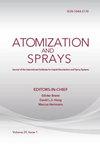饱和沸腾状态下气泡增长和液膜不稳定性对液滴撞击现象的影响
IF 0.9
4区 工程技术
Q4 ENGINEERING, CHEMICAL
引用次数: 0
摘要
蒸发和沸腾是许多工业应用中涉及多相流的过程。然而,对于液体薄膜,有关传热和传质机制的研究很少,需要进一步研究。这项工作的主要目的是评估气泡的形成和脱离,以及随后的冲击现象。因此,我们建立了一个实验装置,并对其进行了调整。一个硼硅玻璃撞击面被置于一个热源之上,热源由一个铝块和 4 个嵌入式盒式加热器组成,通过传导加热液膜。水和正庚烷是实验研究采用的液体,因为它们的热物理性质不同,可以进行更广泛的实验。研究案例包括类似撞击条件下的 0.6 美元无量纲温度。在气泡形成方面,正庚烷显示出较小的气泡直径和较高的释放率,而水则显示出较大的气泡和较低的释放率。从定性角度看,接近饱和温度的液膜温度并不直接影响液冠的形成和后期的二次雾化。在撞击的后期阶段,中心射流高度和破裂受薄膜温度的影响,这与热物理性质的变化有关。本文章由计算机程序翻译,如有差异,请以英文原文为准。
Influence of bubble growth and liquid film instabilities on droplet impact phenomena under saturated boiling regimes
Evaporation and boiling are processes that occur in many industrial applications involving multiphase flows. For liquid films, however, studies are scarce regarding heat and mass transfer mechanisms, and require further research. The main objective of this work is to evaluate bubble formation and detachment, followed by the impact phenomena. Therefore, an experimental setup was built and adapted for this purpose. A borossilicate glass impact surface is placed over a heat source, which consists of an aluminium block with 4 embedded cartridge heaters which heats the liquid film by conduction. Water and n-heptane are the fluids adopted for the experimental study, as the differences in thermophysical properties allow for a wider range of experiments. Study cases include dimensionless temperatures of $\theta>0.6$ for similar impact conditions. In terms of bubble formation, n-heptane displays smaller bubble diameters and higher release rates, whereas water exhibits larger bubbles and lower rates. Qualitatively, liquid film temperatures close to the saturation temperature do not reveal a direct influence on the crown development and posterior secondary atomisation. For later stages of the impact, the central jet height and breakup are influenced by the film temperature, which is associated with the variation of thermophysical properties.
求助全文
通过发布文献求助,成功后即可免费获取论文全文。
去求助
来源期刊

Atomization and Sprays
工程技术-材料科学:综合
CiteScore
2.10
自引率
16.70%
发文量
54
审稿时长
1.7 months
期刊介绍:
The application and utilization of sprays is not new, and in modern society, it is extensive enough that almost every industry and household uses some form of sprays. What is new is an increasing scientific interest in atomization - the need to understand the physical structure of liquids under conditions of higher shear rates and interaction with gaseous flow. This need is being met with the publication of Atomization and Sprays, an authoritative, international journal presenting high quality research, applications, and review papers.
 求助内容:
求助内容: 应助结果提醒方式:
应助结果提醒方式:


